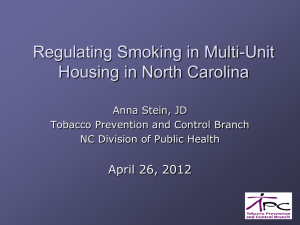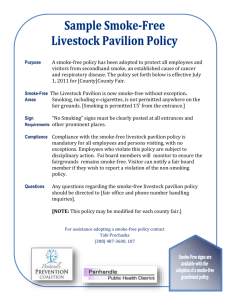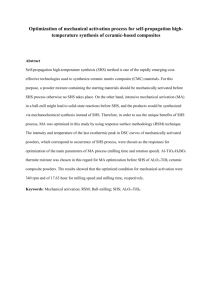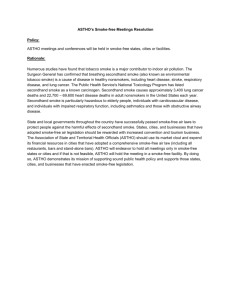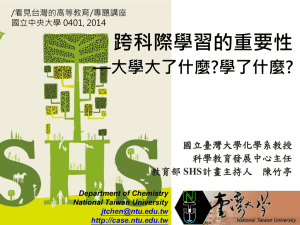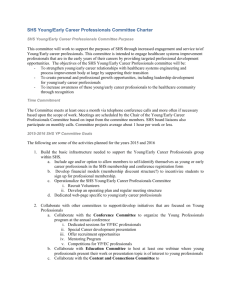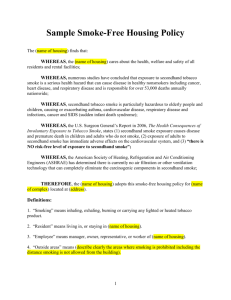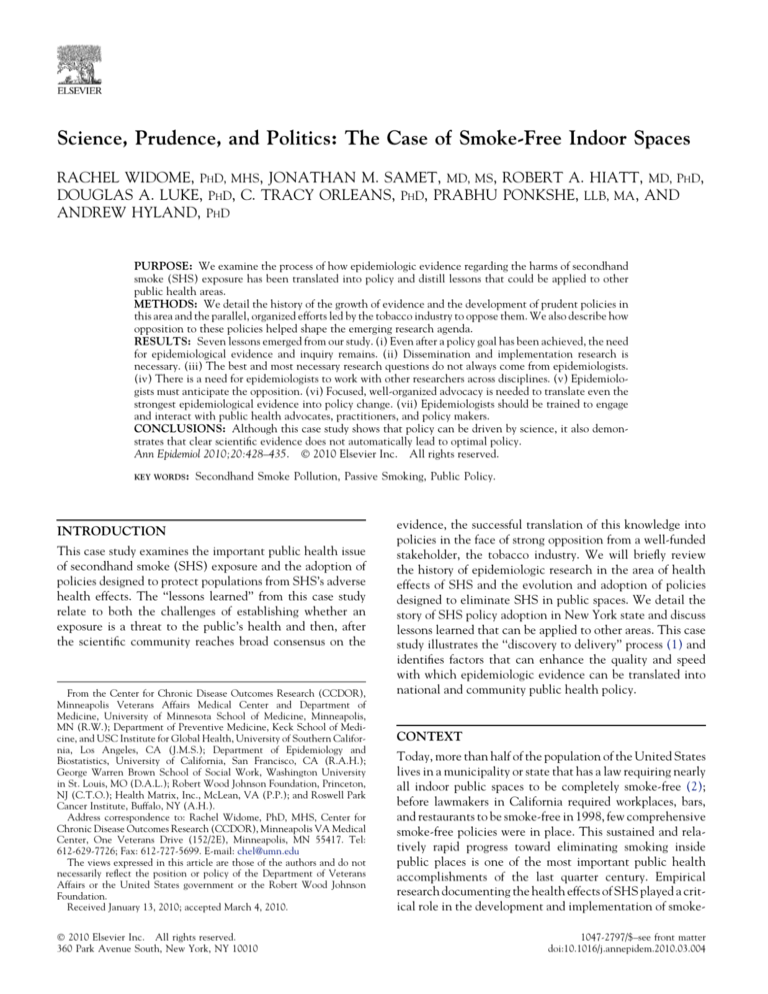
Science, Prudence, and Politics: The Case of Smoke-Free Indoor Spaces
RACHEL WIDOME, PHD, MHS, JONATHAN M. SAMET, MD, MS, ROBERT A. HIATT, MD, PHD,
DOUGLAS A. LUKE, PHD, C. TRACY ORLEANS, PHD, PRABHU PONKSHE, LLB, MA, AND
ANDREW HYLAND, PHD
PURPOSE: We examine the process of how epidemiologic evidence regarding the harms of secondhand
smoke (SHS) exposure has been translated into policy and distill lessons that could be applied to other
public health areas.
METHODS: We detail the history of the growth of evidence and the development of prudent policies in
this area and the parallel, organized efforts led by the tobacco industry to oppose them. We also describe how
opposition to these policies helped shape the emerging research agenda.
RESULTS: Seven lessons emerged from our study. (i) Even after a policy goal has been achieved, the need
for epidemiological evidence and inquiry remains. (ii) Dissemination and implementation research is
necessary. (iii) The best and most necessary research questions do not always come from epidemiologists.
(iv) There is a need for epidemiologists to work with other researchers across disciplines. (v) Epidemiologists must anticipate the opposition. (vi) Focused, well-organized advocacy is needed to translate even the
strongest epidemiological evidence into policy change. (vii) Epidemiologists should be trained to engage
and interact with public health advocates, practitioners, and policy makers.
CONCLUSIONS: Although this case study shows that policy can be driven by science, it also demonstrates that clear scientific evidence does not automatically lead to optimal policy.
Ann Epidemiol 2010;20:428–435. Ó 2010 Elsevier Inc. All rights reserved.
KEY WORDS:
Secondhand Smoke Pollution, Passive Smoking, Public Policy.
INTRODUCTION
This case study examines the important public health issue
of secondhand smoke (SHS) exposure and the adoption of
policies designed to protect populations from SHS’s adverse
health effects. The ‘‘lessons learned’’ from this case study
relate to both the challenges of establishing whether an
exposure is a threat to the public’s health and then, after
the scientific community reaches broad consensus on the
From the Center for Chronic Disease Outcomes Research (CCDOR),
Minneapolis Veterans Affairs Medical Center and Department of
Medicine, University of Minnesota School of Medicine, Minneapolis,
MN (R.W.); Department of Preventive Medicine, Keck School of Medicine, and USC Institute for Global Health, University of Southern California, Los Angeles, CA (J.M.S.); Department of Epidemiology and
Biostatistics, University of California, San Francisco, CA (R.A.H.);
George Warren Brown School of Social Work, Washington University
in St. Louis, MO (D.A.L.); Robert Wood Johnson Foundation, Princeton,
NJ (C.T.O.); Health Matrix, Inc., McLean, VA (P.P.); and Roswell Park
Cancer Institute, Buffalo, NY (A.H.).
Address correspondence to: Rachel Widome, PhD, MHS, Center for
Chronic Disease Outcomes Research (CCDOR), Minneapolis VA Medical
Center, One Veterans Drive (152/2E), Minneapolis, MN 55417. Tel:
612-629-7726; Fax: 612-727-5699. E-mail: chel@umn.edu
The views expressed in this article are those of the authors and do not
necessarily reflect the position or policy of the Department of Veterans
Affairs or the United States government or the Robert Wood Johnson
Foundation.
Received January 13, 2010; accepted March 4, 2010.
Ó 2010 Elsevier Inc. All rights reserved.
360 Park Avenue South, New York, NY 10010
evidence, the successful translation of this knowledge into
policies in the face of strong opposition from a well-funded
stakeholder, the tobacco industry. We will briefly review
the history of epidemiologic research in the area of health
effects of SHS and the evolution and adoption of policies
designed to eliminate SHS in public spaces. We detail the
story of SHS policy adoption in New York state and discuss
lessons learned that can be applied to other areas. This case
study illustrates the ‘‘discovery to delivery’’ process (1) and
identifies factors that can enhance the quality and speed
with which epidemiologic evidence can be translated into
national and community public health policy.
CONTEXT
Today, more than half of the population of the United States
lives in a municipality or state that has a law requiring nearly
all indoor public spaces to be completely smoke-free (2);
before lawmakers in California required workplaces, bars,
and restaurants to be smoke-free in 1998, few comprehensive
smoke-free policies were in place. This sustained and relatively rapid progress toward eliminating smoking inside
public places is one of the most important public health
accomplishments of the last quarter century. Empirical
research documenting the health effects of SHS played a critical role in the development and implementation of smoke1047-2797/$–see front matter
doi:10.1016/j.annepidem.2010.03.004
AEP Vol. 20, No. 6
June 2010: 428–435
Selected Abbreviations and Acronyms
SHS Z secondhand smoke
EPA Z Environmental Protection Agency
free policies. However, although this case study tells the
story of the successful spread of policies to prohibit smoking
in public places, including restaurants and bars, it also illustrates that even the best scientific evidence is not a guarantee of rapid, consistent, or universal public health policy
development. This case study also highlights the skill
needed to mount and manage responses to attacks from
those whose interests are threatened and the ability to
harness the power of an orchestrated public health advocacy
effort.
HISTORY OF EPIDEMIOLOGIC EVIDENCE ON
THE DANGERS OF SHS
For most of the 20th century, smoking anywhere and at any
time was commonplace in the United States; smoking bans
were rare. But by the 1970s, the weight of scientific research
was pointing to real dangers that were direct results of SHS
exposure. The 1971 Surgeon General’s Report, in relation to
the risks of smoking and pregnancy, was the first Surgeon
General’s Report to propose a government ban on smoking
in public places (3). However, the 1972 Surgeon General’s
Report was the first to explicitly identify involuntary
smoking (i.e., SHS exposure) as a health risk (4). The landmark 1981 study by Hirayama and colleagues (5) demonstrated that non-smoking Japanese women married to men
that smoked had greater rates of lung cancer compared
with nonsmoking women married to nonsmoking men. By
the mid-1980s, nearly 30 studies (6) had linked SHS exposure to increased risk for lower respiratory illnesses in infants
and to increased respiratory symptoms and lower lung function in children.
Additional evidence continued to grow that further
solidified the consensus that SHS was damaging to health.
The 1986 Surgeon General’s report concluded that SHS
causes lung cancer in nonsmokers and is associated with
a variety of respiratory conditions in children (6). In 1992
the U.S. Environmental Protection Agency (EPA)
concluded that the widespread exposure to SHS in the
United States presents a serious and substantial public
health impact and classified SHS as a Group A carcinogen
(7). The epidemiological evidence on SHS and lung cancer
continued to grow; for the United States, the multi-site
study published in 1994 by Fontham and others (8) was
particularly notable because of its size and methodological
rigor. Finally, the 2006 Surgeon General’s report stated,
‘‘the debate is over’’ and ‘‘the science is clear’’ that SHS
Widome et al.
SMOKE-FREE INDOOR SPACES
429
causes lung cancer and heart disease in nonsmokers, among
many other conditions (9).
THE WAVE OF POLICIES DESIGNED TO LIMIT
SHS EXPOSURE
In 1975 Arizona, Connecticut, and Minnesota implemented
the first policies in the United States that required portions
of certain types of public spaces to be smoke free (10).
However, it was not until a decade later, subsequent to
the 1986 Surgeon General’s Report, that the tide of local
policies banning smoking really began to rise (6). Nearly
10 years after the first policies, in 1995, California became
the first state to require all restaurants to be completely
smoke free; the ban was expanded to bars in 1998. As of
January 2010, 41% of the U.S. population lives in a community that requires all indoor workplaces (including restaurants and bars) to be completely smoke-free (Fig. 1) (2),
and there are more than 3000 jurisdictions that have passed
smoke-free workplace, restaurant, or bar legislation (11). A
critically important fact in these policy debates is that the
epidemiologic literature has consistently shown that SHS
is associated with disease in nonsmokers. Thus, the primary
argument for smoke-free legislation has been that workers
should not be required to inhale a toxic substance as a condition of employment. This rationale has been compelling and
successful, and without the scientific evidence of harm as
a rationale, the rate of smoke-free policy adoption would
likely have been slower.
OPPOSITION TO POLICY AND CONCERNS
OUTSIDE OF HEALTH
Considerable effort has been mounted by the tobacco
industry to challenge the scientific evidence, and in some
cases these efforts have prevented or delayed comprehensive
smoke-free policy implementation. As early as the 1981
Hirayama study, the tobacco industry took defensive action
against scientific evidence on SHS, attempting to instill
doubt in the assertion that SHS causes disease (12). This
strategy mirrored that used earlier for active smoking and
disease. The model of creating doubt and maintaining
controversy, along with funding research to counter ‘‘positive’’ findings, can be traced to the early 1950s (13). The
tobacco industry viewed the 1992 EPA decision that SHS
was a human carcinogen as a particularly serious threat
because they feared regulatory consequences via the Occupational Safety and Health Administration that would
apply to workplaces across the country (9). Acting through
public relations firms, these well-documented, organized
campaigns, orchestrated by the tobacco industry, were designed to convince the public that the epidemiologic
430
Widome et al.
SMOKE-FREE INDOOR SPACES
AEP Vol. 20, No. 6
June 2010: 428–435
WA
100
MT
100
OR
100
ND
17.6
ID
0
WY
2.9
NV
0
CA
25.9
MN
100
CO
10.7
AZ
100
IL
100
OK
0
NM
36.6
TX
28
HI
100
NY
100
MI
0
IA
100
KS
24.5
ME
100
NH
0
WI
5.6
SD
0
NE
100
UT
100
VT
100
MO
12.5
IN
8.7
OH
100
KY
29.8
MS
6.8
AL
3.4
CT
0
NJ
100
WV
34.4 VA
0
RI
100
DE
MD 100
100
NC
0
TN
0
AR
0.1
PA
0
MA
100
SC
25.8
GA
0.1
Puerto Rico
100
LA
0
FL
0
AK
42.1
State/Commonwealth Population Covered by 100% Smokefree WRB* Laws
<1%
1-25%
26-50%
51-75%
76-99%
100%
FIGURE 1. Percent of population covered by 100% smoke-free workplace laws in effect as of January 5, 2010. From the American
Nonsmokers’ Rights Foundation (http://www.no-smoke.org).
evidence was questionable (14–16). Evidence that was
contrary to tobacco industry interests was labeled ‘‘junk
science.’’ The industry recruited consultants who questioned emerging findings, and it began its own ‘‘sound
science’’ program with the mission of discrediting the
evidence presented in the EPA report (15).
Ironically, the fierce opposition to policies has sometimes
worked to indirectly strengthen the evidence and help
support policy implementation. When smoke-free policies
first were introduced, opponents argued that the public did
not support these policies, that assuring compliance with
the laws would be difficult, that the policies would devastate
the hospitality industry, and that suitable compromises such
as improved heating, ventilating, and air conditioning
systems were sufficient for protecting health (17).
Each of these points posed a testable hypothesis for
empirical research studies, and epidemiologists used the
scientific method to systematically examine the veracity of
each of these claims. Surveys documented that the vast
majority of the population prefers smoke-free indoor spaces
and evaluations in many places showed that compliance
with smoke-free laws was extremely high with relatively
mild and transient implementation issues (18–20).
Additionally, researchers found that business revenue was
generally not negatively impacted by the presence of smokefree policies in study after study across the nation (21).
Finally, it was determined technological fixes such as better
ventilation or filtration systems did not eliminate the health
risks posed by SHS exposure in the workplace (22, 23). This
program of research essentially rendered many of the
industry arguments to smoke-free policy adoption as moot.
As the evidence-base for the adverse health effects of
SHS exposure became established in the general public’s
mind, debate switched to the potential business and
economic effects of implementing clean indoor air policies.
In turn, health policy and economics scientists were able to
establish that states and communities implementing SHS
policies would not see any negative economic or business
consequences (24). The only opposition argument that still
carries sway in current policy debates, and one that is outside
the realm of a testable epidemiologic study, is the philosophical argument about whether or the government has
AEP Vol. 20, No. 6
June 2010: 428–435
the right to infringe on personal and business liberties for the
sake of public health.
THE STATE OF EVIDENCE: HOW MUCH IS
ENOUGH?
Assessments of potential for harm in epidemiology are
accompanied by some degree of uncertainty. The question
of when epidemiological evidence warrants moving forward
and promoting a public health policy is determined by many
factors, some of which lie outside of the recent common
practice of epidemiology, although not of public health.
With all interventions, policy or otherwise, the amount of
epidemiologic evidence for causal effects that is needed to
motivate action differs by purpose (25).
Gostin (26) offers a multiple-step model for evaluating
how and when to move toward public health regulation.
An important premise of this approach is that the level of
risk needed to justify an intervention depends upon the
potential burdens that the policy places on society. Extending this concept to the reality that epidemiologic evidence
almost inevitably comes with some uncertainty, the SHS
case study illustrates the need to weight potential benefit
against the potential for unintentional harm to individuals
or to society that could come from policies intended to
protect the population from SHS exposure. In the case of
SHS, the weight of evidence demonstrating the harm of
exposure raised the need for prudent policies to reduce exposure and thus harm. The specific points of industry opposition to these policies showed a need for greater research
on unintended consequences, such as the possibility of
economic harm of bans to the hospitality industry. In fact,
as previously mentioned, evaluation research showed that
smoking bans can be implemented at no cost to the hospitality sector or to business in general, or even at a financial
gain because there are savings on cleaning costs and upkeep
for establishments (27, 28). Careful assessments, on the basis
of epidemiologic investigational principles, generated the
needed evidence, thus enabling smoother and more rapid
enactment of the policies over time.
A CLOSER LOOK: THE STORY OF NEW YORK
In July, 2003 New York State became the third U.S. state to
require indoor workplaces, including bars and restaurants, to
prohibit smoking. This legislation culminated in a decade of
local-level debates over the merits of the health argument
that SHS caused disease in nonsmokers as well as other
issues relevant to the implementation of such legislation.
In the early 1990s, New York State already had a law on
the books that required indoor workplaces to be smoke free,
but restaurants and bars were exempt. In 1994, a bill was
Widome et al.
SMOKE-FREE INDOOR SPACES
431
introduced in New York City to prohibit smoking in the
dining areas of restaurants with 50 or more seats (29). After
three spirited public hearings and a modification to the bill
to exempt restaurants with 35 or fewer seats, the bill unanimously passed out of the health committee and was
approved by the full city council with 82% voting in favor
of the bill in December 2003. The Mayor signed it into
law and it became effective April, 1995.
The three arguments made by proponents of a stronger
smoke-free law were as follows: (i) SHS is a health hazard;
(ii) the then current law was inadequate to protect workers
and patrons from SHS; and (iii) the law would not have an
adverse economic impact on restaurants. The answer to the
question of how much evidence is enough came when the
opponents’ counter-arguments shifted to other issues: (i)
the law would be bad for business; (ii) the law was unnecessary; (iii) the law was unfair; and (iv) the law would be
impossible to enforce.
In the 1990s, the health argument was made by citing the
1992 EPA report summarizing the state of the science at the
time along with more recent studies on lung cancer and
other adverse health effects. Evidence on the adverse health
impacts of SHS were the most central and important in
justifying the need for expanding the existing legislation.
The health evidence that SHS caused disease in nonsmokers
was used to make the prudent case that, in fact, the law was
necessary to protect the public’s health. But prudence
without conclusive evidence creates the space for politics
and opposition. In the SHS case, the health evidence was
used to address at least one opposing view, that of fairness,
because, it was argued, that it was not fair for restaurant
workers to risk their health to earn a living. But at the
time the bill was being debated, there was just one published
study on economic outcomes of smoke-free restaurant laws
and it concluded there were no adverse effects (30), and
there were no published studies on compliance issues with
smoke-free laws. However, the testimonials demonstrated
that the laws were largely supported by the majority of the
population and were self enforcing with little additional
resources used to gain high levels of compliance. Note
that the opposition to this legislation was primarily on political and economic groundsdby this time the epidemiologic
evidence was firmly established and not attacked directly.
Around the time that the 1995 smoke-free restaurant law
took effect in New York City, and in response to similar
science-based advocacy efforts, other major population
centers in the state began adopting similar legislation
leaving the state with a patchwork of legislation that still exempted some workplaces (i.e., bars). The 1995 New York
City law provided the right opportunity to study the hypothesized impacts of the law. Studies showed that the people
strongly supported the law (31), compliance with the law
was high, most restaurateurs reported coming into
432
Widome et al.
SMOKE-FREE INDOOR SPACES
compliance with ease and little expense (18), and the hospitality and tourism industry flourished even after the law took
effect (32–34). These findings helped to fuel efforts to
strengthen legislation in local communities in New York
that existed on the grounds of protecting all workers from
SHS.
With this evidence in hand, and effectively communicated by informed advocates, the New York City Council
voted to strengthen the city’s smoke-free law to include all
restaurants and bars in late 2002 with the legislation taking
effect March 2003. Almost immediately afterwards, New
York State passed similar legislation that provided smokefree workplaces, bars, and restaurants throughout the state
taking effect July 2003.
It is important to note that demonstrating that SHS poses
a risk and that the proposed policy solution has greater benefits than burdens is only the first step in the policy change
process. Since the 2003 New York ban went into effect,
systematic follow-up studies have strengthened the
evidence showing causal connections between this type of
SHS policy and both risk reduction as well as health promotion. For instance, several studies showed that after the ban
took effect, hospitality workers had significantly lower
urinary cotinine (a marker for nicotine exposure) levels after
the ban (35) and also reported fewer hours of total SHS
exposure and less sensory (eye, nose, and throat) irritation
(36) compared with before the ban. Hospital admission rates
for acute myocardial infarction were reduced by 8% after the
2003 (37), replicating the results of similar studies conducted in other U.S. communities (38, 39). The evidence
had now begun to narrow the space for politics and opposition. Furthermore, these follow-up evaluations have cited
both when smoke-free policies have been challenged and
when proposals have been put forward to extend them.
Although the cumulative epidemiological evidence on
the dangers of SHS summarized in multiple reports supplied
the essential evidence for smoke-free laws in policy debates
across the country, simply having this evidence in hand was
not sufficient to fuel policy change. Vocal advocates and
well-crafted local, state, and national communication
campaigns were essential to counteract well-financed opposition from the tobacco industry and some sectors of the
business community, which were engaged as allies by the
tobacco industry. It could be debated that passage of New
York City’s smoke-free air law in 1995 was a critical point
for smoke-free air legislation in the United States because
it demonstrated to public health advocates, tobacco control
leaders, and policy makers across the country that the scientific evidence was solid enough to address and disarm. In
addition, by 1995 there was a strong smoke-free air advocacy
infrastructure in place, one that stretched from grassroots/
local advocacy and coalitions, to national-level advocacy
provided by organization that included the Campaign for
AEP Vol. 20, No. 6
June 2010: 428–435
Tobacco Free Kids, Americans for Nonsmokers’ Rights
and the American Cancer Society. Although epidemiologists and other scientists were a part of this effort, they generally lack the experience and training needed to fully
translate evidence into policy recommendations and to
use it strategically in policy debates (40). Dissemination
and implementation research is an important, but insufficiently represented area of training for future epidemiologists (41, 42).
IS THE GLASS NOW HALF FULL? OR HALF
EMPTY?
We have seen in the case of SHS policy that strong scientific
evidence can drive healthy public policy. We selected the
case of smoke-free policy adoption as an example of public
health policy being driven by rigorous epidemiological
research. Certainly the weight of evidence that SHS harms
health has been the key factor in activating policy, influencing so many jurisdictions in the United States to adopt
100% smoke-free regulations for their workplaces. But
why, more than 20 years after the 1986 Surgeon General’s
Report, does more than half the U.S. population live in
a community where smoking is not banned in all public
spaces? Why is it taking so long to implement what the
science is clearly telling us to do?
In general, dissemination and adoption of control strategies based in findings of clinical and epidemiologic studies
and policy takes much longer than it should. One important
reason for the slow pace of translation of discovery into
delivery is that policy scientists are less connected to epidemiologists than could be the case, and this is as true in SHS
research as in other areas of public health. An analysis of 40
years of SHS research found that the policy and intervention scientists only rarely directly cite the work that established the epidemiologic basis for SHS policy (43).
Instead, they were much more likely to cite major summary
reports such as the Surgeon General’s reports or the NCI
Cancer Monographs. However, it takes some time the
evidence base to be summarized in these reports. So perhaps
the pace of translating evidence into policy could be speeded
up by reconnecting policy scientists to epidemiologists.
More generally, public health policy decisions involve
multiple determining factors, of which research evidence
is an important but neither necessary nor sufficient condition for taking action. Even the strongest epidemiological
evidence will not trigger policy change on its own.
Committed leadership and advocacy are essential, along
with carefully constructed messages and media campaigns
that address the concerns of critical audiences (e.g., the
public, policymakers the business community). As Isaacs
and Schroeder (44) point out, highly credible scientific
AEP Vol. 20, No. 6
June 2010: 428–435
evidence can persuade policymakers to withstand attack by
those whose interests are threatened, but significant policy
or social change rarely, if ever, happens without focused,
astute and courageous advocacy. And often, these on-theground advocates are more aware of the types of research
questions that need to be answered solidly to provide to
lawmakers the information that can cement their decisions
(45). In the case of SHS policies, the tobacco industry has
actively undermined the evidence that SHS causes disease
and attempted to instill doubt in the minds of the public
and policymakers. This tactic has served to diminish the
relative strength of the health arguments while increasing
the relative strength of the nonhealth arguments when
protective policies are considered. The ultimate balance
between health and nonhealth arguments in the decisionmaking process differs from community to community,
from state to state, and from country to country and has
evolved over time. Thus, SHS policy implementation has
presented a challenge that requires small studies documenting the local benefits of smoke-free air laws in individual
communities, along with skillful communications and advocacy efforts. The products of the smoke-free campaigns
which include not just the policies and health benefits but
also advocacy toolkits, partnerships, and a greater public
awareness of the issue, have jointly led to a majority being
covered by a 100% smoke-free workplace in 2010 (2).
Thus, the balance has tipped, in our opinion when looking
at progress in the effort to protect the public’s health, the
glass is more than half-full, rather than half-empty.
LESSONS LEARNED
1. Even after a policy goal has been achieved, the need for epidemiological evidence and inquiry remains. After a risk has been
established and a policy strategy created, it is still necessary
to evaluate the policy to learn whether it is associated with
risk reduction and health promotion. In the case of SHS
policy, documenting the decrease in cotinine levels and
cardiovascular disease events in communities that have implemented bans has been an important part of the policy
process. It is also important to do surveillance for any
possible disparities in protection. In places that have
comprehensive bans, continuing evaluation is important
to assure that all are being protected, and provide data
(on issues like public support for the ban and economic
impact) in case the law is ever challenged.
2. Community-based dissemination and implementation
research is necessary. Research questions relating to public
opinion, economic impact, and even health effects had to
be re-asked and studies repeated in local communities to
meet the call for local data. Although not breaking new
Widome et al.
SMOKE-FREE INDOOR SPACES
433
scientific ground on health effects, these studies have
provided invaluable evidence to help inform local
smoke-free policies debates. The need for this type of
research is so prevalent that the Centers for Disease Control
and Prevention has developed a toolkit on conducting the
five different types of studies that can be used to
inform policy debates in the context of local community
situations (46).
3. The best and most necessary research questions do not always
come from epidemiologists. An ear towards the ‘‘users,’’ that is,
community partners, advocates, the local business community and lawmakers, can and must inform research and guide
research questions to the most policy-relevant facets of
a topic. For instance, a city council member’s reluctance
to take a public health stand could be attributable to
a variety of concerns related to potential health impact,
economic impact, and/or public opinions. Knowing what
questions are most relevant to lawmakers can be a guide to
what research questions to ask. Further down the line, partnerships are useful for presenting a strong, consistent
message on the evidence.
4. There is a need for epidemiologists to work with other
researchers across disciplines. With SHS policy, the potential
economic implications of the policies were key factors in
smoke-free policy debates. Epidemiologists are typically
not trained in economic analyses and so cross-disciplinary
partnerships are key.
5. Anticipate and address the opposition. In this case study,
there was a very organized, determined and well-funded coalition of groups that worked against the implementation of
these policies. In the realm of SHS policy, the opposition’s
arguments have been quite predictable and always include
the unfounded claims that smoke-free laws will not be supported, will cause economic hardship, and are not feasible.
There are many public health arenas in which industry
opponents may be formidable. By knowing the arguments
and strategies that have surfaced in the past, communities
looking towards smoke-free policies today can do groundwork, such as conducting studies according to the Centers
for Disease Control and Prevention guidebook that yield
evidence to address opposition arguments.
6. Focused, well-organized advocacy is needed to translate even
the strongest epidemiological evidence into policy change. Simply
having strong evidence was not sufficient to fuel policy
change. Vocal advocates and well-crafted local, state, and
national communication campaigns were essential to counteract well-financed opposition from the tobacco industry
and business community.
7. Train future epidemiologist to engage and interact with public
health advocates, practitioners and with policy makers. Few
epidemiologists are trained or prepared manage the response
to controversial science like research and SHS effects and
policies. Getting involved in this kind of research can be
434
Widome et al.
SMOKE-FREE INDOOR SPACES
daunting for junior researchers. Remaining true to the
science and facing unpleasant public encounters that they
neither expect nor are typically trained to deal with through
their academic programs, is quite challenging. If we want the
findings of epidemiological research to be successfully translated into policy, we need to train students and junior investigators on how to engage and successfully communicate
their work and its implications to relevant stakeholders.
For instance, The Robert Wood Johnson Foundation’s
Substance Abuse Policy Research Program and the Center
for Tobacco-Free Kids provides this kind of training for
many researchers investigating smoke free air laws and
policies.
CONCLUSIONS
AEP Vol. 20, No. 6
June 2010: 428–435
Washington, DC: US Department of Health and Human Services, Public
Health Service, Centers for Disease Control; 1986.
7. U.S. Environmental Protection Agency. Respiratory Health Effects of
Passive Smoking: Lung Cancer and Other Disorders. publication no.
EPA 600/6-90/006F. Washington, DC: U.S. Environmental Protection
Agency, Office of Health and Environmental Assessment, Office of Atmospheric and Indoor Air Programs; 1992.
8. Fontham ET, Correa P, Reynolds P, Wu-Williams A, Buffler PA, Greenberg RS, et al. Environmental tobacco smoke and lung cancer in
nonsmoking women. A multicenter study. JAMA. 1994;271:1752–1759.
9. U.S. Department of Health and Human Services. The Health Consequences of Involuntary Exposure to Tobacco Smoke: a Report of the
Surgeon General. Atlanta, GA: U.S. Department of Health and Human
Services, Centers for Disease Control and Prevention, Coordinating
Center for Health Promotion, National Center for Chronic Disease
Prevention and Health Promotion, Office on Smoking and Health; 2006.
10. U.S. Department of Health and Human Services. The Health Consequences of Involuntary Exposure to Tobacco Smoke: A Report of the
Surgeon General. Atlanta, GA: U.S. Department of Health and Human
Services, Centers for Disease Control and Prevention, Coordinating
Center for Health Promotion, National Center for Chronic Disease
Prevention and Health Promotion, Office on Smoking and Health; 2006.
The case of SHS offers a rich platform for considering the
process of translating epidemiologic evidence to policy.
Epidemiologists working on the forefront of translating
other risk prevention areas, where the evidence is intuitively
pointing to prudent policy options, can learn from both the
barriers faced and successes achieved over the decades of
work in the area of SHS policy. The history of SHS policy
translation demonstrates that working locally and with
those outside of the discipline of epidemiology is essential
for achieving most public health policy goals and that
science is not the only factor considered. Even with strong
evidence in hand, the opposition to public health policies
can be very effective at halting and even reversing progress
and so, answering opposition must be a dynamic, iterative
endeavor. Finally, continuous, ongoing, and local policy
evaluations are important to spread effective and protective
policy initiatives.
18. Hyland A, Cummings KM, Wilson MP. Compliance with the New York
City Smoke-Free Air Act. J Public Health Manag Pract. 1999;5:43–52.
REFERENCES
19. Skeer M, Land ML, Cheng DM, Siegel MB. Smoking in Boston bars before
and after a 100% smoke-free regulation: An assessment of early compliance. J Public Health Manag Pract. 2004;10:501–507.
11. American Non-Smokers’ Rights Foundation. Overview ListdHow Many
Smokefree Laws. Americans for Non-Smokers Rights. 2010. Available
at: http://www.no-smoke.org/pdf/mediaordlist.pdf. Accessed April 2, 2010.
12. Baba A, Cook DM, McGarity TO, Bero LA. Legislating ‘‘sound science’’:
The role of the tobacco industry. Am J Public Health. 2005;95(Suppl
1):S20–27.
13. Brandt AM. Cigarette Century: The Rise, Fall, and Persistence of the
Product That Defined America. New York, NY: Basic Books; 2007.
14. Michaels D. Doubt is Their Product, How Industry’ Assault on Science
Threatens Your Health. Oxford, UK: Oxford University Press; 2008.
15. Ong EK, Glantz SA. Constructing ‘‘sound science’’ and ‘‘good epidemiology’’: Tobacco, lawyers, and public relations firms. Am J Public Health.
2001;91:1749–1757.
16. Samet JM, Burke TA. Turning science into junk: The tobacco industry
and passive smoking. Am J Public Health. 2001;91:1742–1744.
17. World Health Organization. Protection from exposure to second-hand tobacco
smoke. Policy Recommendations. 2007. Available at: http://whqlibdoc.who.
int/publications/2007/9789241563413_eng.pdf. Accessed April 2, 2010.
1. National Cancer Institute. The nation’s progress in cancer research: An annual
report for 2003. NIH Publication No. 04-5536. Bethesda, MD: National Institutes of Health, US Department of Health and Human Services; 2004.
20. Weber MD, Bagwell DA, Fielding JE, Glantz SA. Long term compliance
with California’s Smoke-Free Workplace Law among bars and restaurants
in Los Angeles County. Tob Control. 2003;12:269–273.
2. Americans for Non-Smokers Rights. Summary of 100% Smokefree State
Laws and Population Protected by 100% U.S. Smokefree Laws. Americans
for Non-Smokers Rights. 2010. Available at: http://www.no-smoke.org/
pdf/SummaryUSPopList.pdf. Accessed April 2, 2010.
21. Scollo M, Lal A, Hyland A, Glantz S. Review of the quality of studies on
the economic effects of smoke-free policies on the hospitality industry.
Tob Control. 2003;12:13–20.
3. Office of the Surgeon General. National Clearinghouse for Smoking and
Health. The Health Consequences of Smoking. DHEW Publication No.
(HSM) 71-7513. Rockville, MD: Public Health Service; 1971.
4. Office of the Surgeon General. National Clearinghouse for Smoking and
Health. The Health Consequences of Smoking. DHEW Publication No.
(HSM) 72-7516. Rockville, MD: Public Health Service; 1972.
5. Hirayama T. Non-smoking wives of heavy smokers have a higher risk of lung
cancer: A study from Japan. Br Med J (Clin Res Ed). 1981;282:183–185.
6. U.S. Department of Health and Human Services. The Health Consequences of Involuntary Smoking: A Report of the Surgeon General. US
Department of Health and Human Services publication CDC 87-83-93.
22. Hyland A, Travers MJ, Dresler C, Higbee C, Cummings KM. A 32-country
comparison of tobacco smoke derived particle levels in indoor public
places. Tob Control. 2008;17:159–165.
23. Repace, J. Controlling Tobacco Smoke Pollution. 6(3). 6-30-2005. ASHRAE Board of Directors. IAQ Applications, Environmental Tobacco
Smoke Position Document.
24. Eriksen MP, Cerak RL. The diffusion and impact of clean indoor air laws.
Annu Rev Public Health. 2008;29:171–185.
25. Savitz DA. Interpreting Epidemiologic Evidence: Strategies for Study
Design and Analysis. Oxford: Oxford University Press; 2001.
26. Gostin LO. Public health law in a new century: Part III: Public health
regulation: A systematic evaluation. JAMA. 2000;283:3118–3122.
AEP Vol. 20, No. 6
June 2010: 428–435
Widome et al.
SMOKE-FREE INDOOR SPACES
435
27. Eriksen M, Chaloupka F. The economic impact of clean indoor air laws.
CA Cancer J Clin. 2007;57:367–378.
New York state after implementation of a comprehensive smoking ban.
Am J Public Health. 2007;97:2035–2039.
28. International Agency for Research on Cancer. Evaluating the Effectiveness of Smoke-free Policies. Geneva: World Health Organization; 2009.
38. Sargent RP, Shepard RM, Glantz SA. Reduced incidence of admissions for
myocardial infarction associated with public smoking ban: Before and after
study. BMJ. 2004;328:977–980.
29. Clarke H, Wilson MP, Cummings KM, Hyland A. The campaign to enact New
York City’s Smoke-Free Air Act. J Public Health Manag Pract. 1999;5:1–13.
30. Glantz SA, Smith LR. The effect of ordinances requiring smoke-free
restaurants on restaurant sales. Am J Public Health. 1994;84:1081–1085.
31. Hyland A, Cummings KM. Consumer response to the New York City
Smoke-Free Air Act. J Public Health Manag Pract. 1999;5:28–36.
32. Hyland A, Cummings KM. Restaurant employment before and after the
New York City Smoke-Free Air Act. J Public Health Manag Pract.
1999;5:22–27.
39. Committee on Secondhand Smoke Exposure and Acute Coronary Events,
Institute of Medicine. Secondhand Smoke Exposure and Cardiovascular
Effects, making sense of the evidence. Washington, DC: National Academies Press; 2009.
40. Savitz DA, Poole C, Miller WC. Reassessing the role of epidemiology in
public health. Am J Public Health. 1999;89:1158–1161.
41. Hiatt RA. Epidemiology: Key to translational, team, and transdisciplinary
science. Ann Epidemiol. 2008;18:859–861.
33. Hyland A, Cummings KM, Nauenberg E. Analysis of taxable sales receipts:
Was New York City’s Smoke-Free Air Act bad for restaurant business?
J Public Health Manag Pract. 1999;5:14–21.
42. Lee NL, Samet JM. ACE forum report: the making of an epidemiologist–
necessary components for doctoral education and training. Ann Epidemiol.
2003;13:552–556.
34. Hyland A, Cummings KM. Restaurateur reports of the economic impact of
the New York City Smoke-Free Air Act. J Public Health Manag Pract.
1999;5:37–42.
43. Harris JK, Luke DA, Zuckerman RB, Shelton SC. Forty years of secondhand smoke research: The gap between discovery and delivery.
Am J Prev Med. 2009;36:538–548.
35. Abrams SM, Mahoney MC, Hyland A, Cummings KM, Davis W, Song L.
Early evidence on the effectiveness of clean indoor air legislation in New
York State. Am J Public Health. 2006;96:296–298.
44. Isaacs SL, Schroeder SA. Where the public good prevailed. Am Prospect.
2001;June:26–30.
36. Farrelly MC, Nonnemaker JM, Chou R, Hyland A, Peterson KK, Bauer
UE. Changes in hospitality workers’ exposure to secondhand smoke
following the implementation of New York’s smoke-free law. Tob Control.
2005;14:236–241.
37. Juster HR, Loomis BR, Hinman TM, Farrelly MC, Hyland A, Bauer UE,
et al. Declines in hospital admissions for acute myocardial infarction in
45. Petticrew M, Roberts H. Evidence, hierarchies, and typologies: Horses for
courses. J Epidemiol Community Health. 2003;57:527–529.
46. Loomis BR, Farrelly MC, Pais J, Hyland A, Mowery P, Babb S, et al,
U.S. Department of Health and Human Services. Evaluation toolkit
for smoke-free policies. Atlanta, GA: Centers for Disease Control and Prevention; 2008. Available at: http://www.cdc.gov/tobacco/basic_information/
secondhand_smoke/evaluation_toolkit/pdfs/evaluation_toolkit.pdf.

